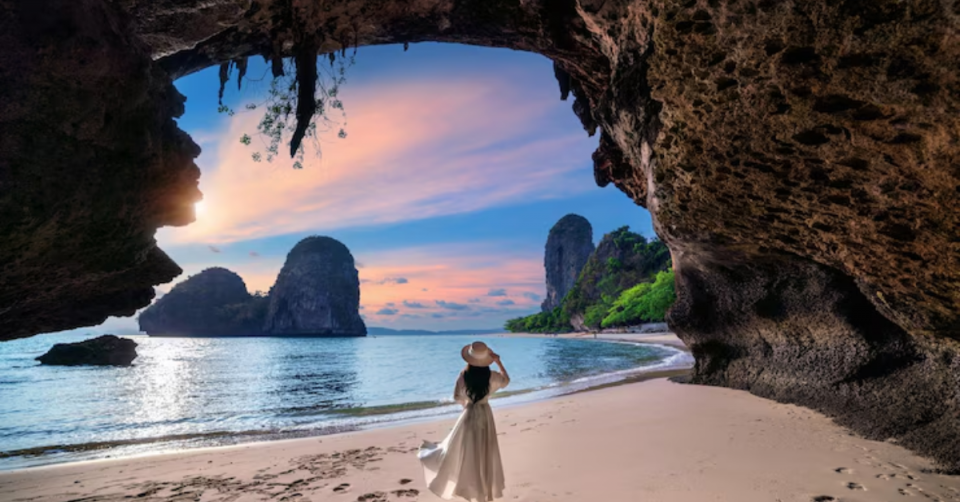Nestled along Thailand’s Andaman coast, Krabi is often celebrated for its dramatic limestone cliffs and pristine beaches. Yet beyond these postcard-perfect scenes lies a vibrant local culture waiting to be discovered. This guide takes you beyond the tourist trail to experience authentic Krabi life through its bustling markets, serene temples, and lesser-known treasures that locals cherish.
Morning Market Magic
Krabi Town Morning Market (Talad Sod)
Begin your journey as locals do—with a visit to Krabi Town’s Morning Market. Opening before dawn around 4:00 AM, this is where Krabi truly comes alive. Unlike tourist-oriented night markets, this daily gathering serves as the community’s pantry and social hub.
Wander through aisles of:
- Fresh-caught seafood still glistening from the Andaman Sea
- Tropical fruits in a rainbow of colors, many of which you won’t find back home
- Local delicacies like khanom chin (rice noodles served with curry) and moo hong (Krabi-style braised pork)
The market begins winding down by 9:00 AM, so arrive early to witness locals engaging in animated haggling and friendly conversation over steaming cups of Thai coffee.
Maharaj Market
For a more permanent market experience, visit Maharaj Market in downtown Krabi. This covered market hosts dozens of food stalls serving authentic southern Thai cuisine. Try the fiery gaeng tai pla (fermented fish entrail curry)—a regional specialty not for the faint-hearted but beloved by locals for its complex flavors.
Temple Treasures
Wat Kaew Korawaram
Krabi’s most prominent temple sits atop a hill in Krabi Town, providing a tranquil escape from the bustle below. Unlike the grand temples of Bangkok, Wat Kaew offers a glimpse into everyday Thai Buddhism. Visit in the early evening when locals come to make merit and monks gather for evening chants, filling the white temple with soothing rhythmic prayers.
Tiger Cave Temple (Wat Tham Suea)
While somewhat known to tourists for its 1,237 steps leading to panoramic views, few visitors explore the actual cave system that gives this temple its name. The lower temple complex houses several meditation caves where monks practice in solitude. Early mornings offer a chance to witness alms-giving ceremonies and perhaps receive a blessing from resident monks.
Hidden Gems
Ban Koh Klang
Just a short longtail boat ride from Krabi Town lies the island community of Koh Klang. This car-free Muslim fishing village maintains traditional ways of life rarely seen in more developed areas. Spend a day:
- Learning batik fabric painting from local artisans
- Watching fishermen construct traditional boats
- Trying your hand at rice farming in emerald paddies
- Savoring seafood caught and prepared by village families
Arrange a homestay to truly immerse yourself in the rhythms of island life.
Thung Teao Forest Natural Park
Beyond the famous Emerald Pool lies a network of less-visited trails through pristine rainforest. Local guides can show you medicinal plants used in traditional Thai remedies and hidden streams where you might spot the rare Pitta Gurney bird—one of the world’s most endangered avian species.
Local Coffee Culture at Hub Café
Krabi’s emerging coffee scene reflects the meeting of traditional Thai hospitality with contemporary café culture. Hub Café in Krabi Town sources beans from northern Thailand’s hill tribes and serves them in a converted traditional wooden house. The owner, a Krabi native who studied overseas, returned to celebrate local flavors through modern brewing methods.
Seasonal Celebrations
Loy Krathong
If visiting in November, don’t miss Loy Krathong celebrations at Thara Park. While tourists flock to major destinations like Chiang Mai for this lantern festival, Krabi’s celebration maintains an intimate, family-oriented atmosphere. Local families craft krathongs (floating offerings) from banana leaves and flowers, then release them into the Krabi River with whispered prayers.
Chak Phra Festival
This uniquely southern Thai Buddhist celebration happens after the rains retreat (usually October). Buddha images are paraded through town on elaborately decorated floats, accompanied by traditional music and dance. The procession begins at Wat Kaew and winds through town, with locals offering food and drinks to participants and spectators alike.
Practical Tips for Cultural Immersion
- Transportation: Rent a motorbike to explore at your own pace, but consider hiring a local guide for at least one day to discover truly hidden spots.
- Language: Learn basic Thai phrases—southern Thais deeply appreciate visitors who make an effort to communicate in their language.
- Dress Code: For temple visits, cover shoulders and knees. Bring a light scarf that can be quickly wrapped as needed.
- Timing: The hour after dawn and before dusk offers magical light for photography and more comfortable temperatures for exploration.
- Respect: When visiting religious sites or local homes, remove shoes before entering and avoid pointing feet toward Buddha images or people.
Conclusion
Krabi’s true magic lies not just in its natural wonders but in the warmth of its people and the richness of its cultural tapestry. By venturing beyond the beaches and taking time to engage with local life, you’ll discover a side of Krabi that many visitors miss—one filled with genuine smiles, ancient traditions, and the authentic rhythm of daily life in southern Thailand.




